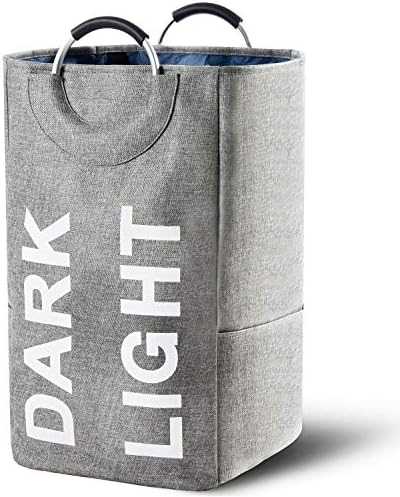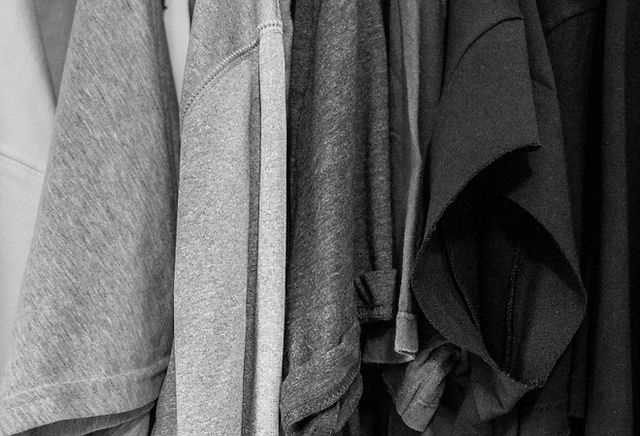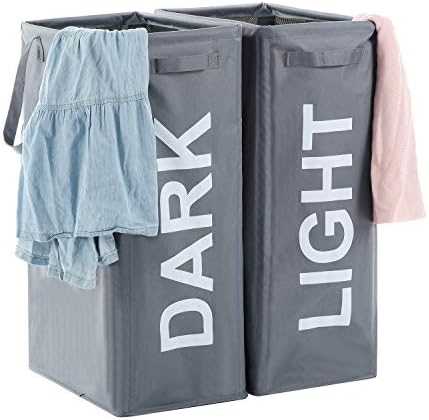




In the world of laundry, determining whether grey is considered light or dark can be a subject of debate. With various shades of grey available in clothing and fabrics, it can be confusing to know where grey falls on the light-dark spectrum when it comes to sorting laundry.
Grey is a versatile color that can range from light to dark depending on the specific shade. Light grey is generally closer to the white end of the spectrum, while dark grey tends to be closer to the black end. However, there is no definitive answer as to whether grey should be classified as light or dark for laundry purposes.
One expert opinion suggests that grey should be considered as a mid-tone color, falling somewhere between light and dark. This means that when sorting laundry, it may be best to treat grey items as a separate category instead of assigning them to either the light or dark pile.
Another factor to consider when determining whether grey is light or dark for laundry is the specific fabric and type of garment. Certain materials may cause a grey color to appear lighter or darker than it actually is. Additionally, the colorfastness of the fabric may affect how it should be sorted.
In conclusion, the classification of grey as light or dark for laundry purposes may vary depending on personal preference and the specific shade of grey. It is recommended to consult the care labels on clothing items for specific instructions on how to launder grey garments. Taking into account the fabric type, colorfastness, and personal judgment can help in making the best decision when sorting grey laundry.
Understanding Grey Colors for Laundry

Grey is a versatile color that is commonly used in laundry. It is often considered a neutral color because it is a mix of black and white. However, when it comes to determining whether grey is light or dark for laundry purposes, it is important to consider the specific shade of grey.
Shades of Grey for Laundry

Grey can vary in shade, ranging from very light to very dark. Lighter shades of grey tend to have more white in them, while darker shades have more black. When choosing grey laundry items, it is important to consider the specific shade in order to determine whether it is light or dark.
Light grey is closer in appearance to white and is often considered a light color for laundry purposes. It is commonly used for delicate items, such as white-based fabrics or light-colored clothing. Light grey can help prevent color bleeding and fading, as it is less likely to transfer color during the washing process.
On the other hand, dark grey is closer in appearance to black and is considered a dark color for laundry. It is commonly used for dark-colored clothing, such as black or navy items. Dark grey can help to maintain the color intensity of these items and prevent them from fading over time.
Considerations for Grey Laundry Items

When washing grey laundry items, there are a few considerations to keep in mind:
- Separate light and dark greys: If you have both light and dark grey items, it is advisable to separate them during the washing process. This will help prevent color bleeding and maintain the appearance of the garments.
- Use cold water: Washing grey items in cold water can help preserve their color and prevent fading. Hot water may cause the color to bleed or fade more quickly.
- Choose appropriate detergent: When washing grey items, it is important to choose a detergent that is suitable for colored fabrics. This will help maintain the color and prevent any unwanted fading or bleeding.
- Follow care instructions: Always check the care labels on your grey items for specific washing instructions. Different fabrics may have different requirements, so it is important to follow the recommended care instructions to avoid damaging the garments.
By understanding the different shades of grey and taking the necessary precautions, you can keep your grey laundry items looking their best and prevent any unwanted color fading or bleeding.
Is Grey Light or Dark for Laundry?
When it comes to classifying the color grey for laundry purposes, it can be considered as either light or dark, depending on the specific shade of grey.
Grey is an intermediate color between black and white. It is often associated with neutrality and is widely used in various designs and clothing. Different shades of grey can range from very light to very dark, and this can affect how it is categorized for laundry purposes.
If the grey garment is a lighter shade, it is generally considered a light color for laundry. Light colors are traditionally washed together, as they have a lower risk of bleeding or fading. It is recommended to wash lighter shades of grey with similar light colors, such as pastels or other pale hues.
However, if the grey fabric is a darker shade, it is classified as a dark color for laundry purposes. Dark colors tend to bleed and fade more easily, so it is important to wash them separately or with other dark-colored garments to minimize damage. Washing darker shades of grey with other dark colors, such as black or navy blue, can help prevent bleeding and preserve the color.
For best results, always check the care label on the grey garment for specific washing instructions. The care label will provide guidance on the recommended washing temperature, cycle, and whether the garment should be washed with similar colors or separately.
In summary, the classification of grey as a light or dark color for laundry depends on the specific shade. Lighter shades of grey are considered light colors and can be washed with other light colors, while darker shades are classified as dark colors and should be washed separately or with other dark-colored garments. Always follow the care label instructions for the best laundry practices.
Factors That Determine Light or Dark Grey
When it comes to determining if grey is considered light or dark for laundry, there are several factors that come into play. These factors can help you decide whether to treat grey clothes as light or dark when sorting your laundry.
- Shade of Grey: The shade of grey can vary, ranging from very light grey to dark charcoal. Lighter shades of grey are often considered light, while darker shades are considered dark.
- Contrast: The contrast between the grey fabric and any patterns or designs on it can also influence whether it is considered light or dark. For example, a light grey fabric with a dark pattern might be considered dark overall.
- Light Transmission: Another factor to consider is how much light the grey fabric allows to pass through it. If the fabric is thin and translucent, it may be considered light, even if the shade of grey itself is on the darker side.
- Fiber Content: The type of fiber the fabric is made from can also affect its classification as light or dark grey. Some fabrics, such as cotton, tend to absorb more dye and appear darker, while others, like polyester, may have a lighter appearance.
- Usage: The intended usage of the grey fabric can also be a factor. If it is intended for casual or everyday wear, it may be considered light. However, if it is intended for formal wear or special occasions, it may be considered dark.
Ultimately, the determination of whether grey is considered light or dark for laundry depends on a combination of these factors. It is important to consider each individual garment and make a judgment based on its specific characteristics. Sorting grey clothes correctly will help ensure they are properly cared for and maintain their appearance over time.
Material Type and Weave
When it comes to laundering grey fabrics, it’s important to consider the material type and weave of the fabric. The material type will dictate the care instructions for cleaning the fabric, while the weave can affect how the fabric absorbs and retains dirt and stains.
Material Type
- Cotton: Grey cotton fabrics are common in clothing and household linens. Cotton is generally easy to launder and can withstand regular washing machine cycles. It’s important to follow the care instructions on the garment or linen tag to ensure proper cleaning.
- Polyester: Grey polyester fabrics are often used in clothing and home decor items. Polyester is a durable and wrinkle-resistant fabric that is easy to care for. Most polyester fabrics can be machine-washed on a gentle cycle and tumble-dried on low heat.
- Wool: Grey wool fabrics are commonly found in suits, coats, and blankets. Wool is a delicate fabric that requires special care. Most wool fabrics should be dry cleaned to avoid shrinking or damage.
- Silk: Grey silk fabrics are luxurious and delicate. Silk requires gentle care and should be hand-washed or dry cleaned to preserve its luster and prevent damage.
Weave
The weave of a fabric can affect how it absorbs and retains dirt and stains. Different weaves have different characteristics:
- Tightly woven fabrics: Fabrics with a tight weave, such as twill or satin, tend to be more resistant to dirt and stains. They are easier to clean as dirt and stains have a harder time penetrating the fabric. However, they may show lint more easily.
- Loosely woven fabrics: Fabrics with a loose weave, such as gauze or chiffon, are more susceptible to dirt and stains. They may require more frequent cleaning and may be more prone to snagging or tearing.
- Knit fabrics: Knit fabrics, such as jersey or rib, have interlocking loops that can trap dirt and stains. They may require more care during laundering to ensure dirt and stains are removed effectively.
When laundering grey fabrics, it’s important to carefully consider the material type and weave to ensure proper cleaning and maintenance. Following the care instructions provided by the manufacturer is always recommended to preserve the quality and longevity of the fabric.
Pigment Concentration
Pigment concentration refers to the amount of pigment present in a given color. It plays a significant role in determining whether a color is considered light or dark.
In the context of laundry, the pigment concentration of a grey color can influence how it is perceived. A lighter grey color would have a lower pigment concentration, while a darker grey color would have a higher pigment concentration.
When it comes to sorting laundry, it is helpful to consider the pigment concentration of the grey garments. Lighter grey clothes can be sorted with other light-colored items, such as whites or pastels, while darker grey clothes may be better suited to dark-colored loads, like blacks or deep colors.
The pigment concentration of a specific grey color can vary depending on the specific dye or colorant used. Different textile manufacturers may have slight variations in the color formulation, leading to differences in pigment concentration.
It is always recommended to consult the care label or follow the manufacturer’s instructions when sorting laundry based on color, including grey garments. This ensures that the garments are treated in the appropriate manner to maintain their color and quality.
Ultimately, the pigment concentration of a grey color can vary, and it is important to consider this when determining whether it should be classified as light or dark for laundry purposes.
Lighting Conditions

Lighting conditions can greatly affect our perception of color. The same shade of grey can appear lighter or darker depending on the lighting in the room. Whether grey is considered light or dark for laundry purposes may vary based on the lighting conditions of the area where the laundry is being done.
Here are some factors related to lighting conditions that can impact how we perceive the color of grey:
1. Natural Lighting

Natural lighting, such as sunlight, can make grey colors appear lighter or brighter. Sunlight has a higher color temperature, which tends to enhance the brightness and visibility of colors.
2. Artificial Lighting
The type of artificial lighting used in the laundry area can also affect how grey appears. Different types of light bulbs have different color temperatures and can emit varying shades of light. Warm white bulbs may make grey appear darker, while cool white or daylight bulbs can make grey appear lighter.
3. Direction and Intensity of Light
The direction and intensity of light can create shadows and highlights on the grey fabric, causing variations in perceived color. Light coming from different angles can create a play of light and shade, making the grey fabric look different under different lighting conditions.
4. Surrounding Colors

The colors of the surrounding environment can also affect our perception of grey. For example, if the laundry area has walls or furniture in bright colors, the grey fabric may appear relatively lighter in comparison.
Considering all these factors, it can be concluded that whether grey is considered light or dark for laundry is subjective and dependent on the lighting conditions of the specific area where the laundry is being done. Factors such as natural lighting, artificial lighting, direction and intensity of light, and surrounding colors can all impact how we perceive the color of grey.
Expert Opinion on Grey Colors
1. Understanding Grey Colors
Grey is a neutral color that is often considered to be neither light nor dark. It is created by mixing black and white in various proportions, resulting in a wide range of shades and tones.
Grey colors can range from light greys, which have a higher proportion of white, to dark greys, which have a higher proportion of black. The specific shade of grey can have different connotations and create different moods.
2. Grey Colors in Laundry
When it comes to laundry, grey colors are generally considered to be easier to maintain compared to light or dark colors. Grey clothing is less likely to show stains and dirt compared to light colors, while also not fading as noticeably as dark colors.
Grey is also a versatile color that can be easily paired with other colors in a laundry load, making it a popular choice for everyday clothing items.
3. Using Grey Colors in Interior Design

In interior design, grey colors have gained popularity due to their ability to create a sophisticated and calming atmosphere. Lighter shades of grey can make a space feel airy and spacious, while darker shades can add depth and drama.
Grey can be used as a neutral backdrop for other colors and accent pieces, allowing them to stand out. It can also be paired with other neutrals, such as white and beige, or combined with bold colors for a striking contrast.
4. Psychological Associations of Grey Colors
Grey colors are often associated with qualities like balance, stability, and neutrality. It can evoke feelings of calmness, elegance, and timelessness.
However, grey can also have different connotations depending on the specific shade and context. For example, lighter greys can be perceived as more youthful and modern, while darker greys can create a more formal and serious atmosphere.
5. Conclusion
In summary, grey colors are neither strictly light nor dark. They offer a versatile and flexible option for both clothing and interior design. Grey can be easily maintained in laundry, create a sophisticated atmosphere in interior spaces, and evoke various psychological associations. Whether light or dark, grey colors have their own unique charm.
FAQ
Is grey colour considered light or dark for laundry?
Grey colour is considered a neutral colour and is typically classified as a light colour for laundry.
I have a grey shirt, should I wash it with dark or light clothes?
It is best to wash a grey shirt with other light-coloured clothes to prevent any potential colour bleeding or transfer.
Can I wash a grey sweater with white clothes?
It is generally not recommended to wash a grey sweater with white clothes, as there is a risk of colour transfer. It is best to wash it with other grey or similar coloured clothes.
Will washing a grey dress with dark clothes cause any damage to the dress?
Washing a grey dress with dark clothes may cause some colour bleeding or transfer, which could potentially damage the dress. It is advisable to wash it with other light or grey clothes to avoid any risks.
Can I wash grey and black clothes together?
Grey and black clothes can usually be washed together, as they are both considered dark colours. However, it is always a good idea to check the care labels on the clothing items and follow any specific instructions provided by the manufacturer.
Is grey considered a light color or a dark color for laundry?
Grey is generally considered a light color for laundry.
What is the expert opinion on whether grey is considered light or dark for laundry?
According to experts, grey is considered a light color for laundry.













